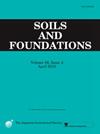Effect of suction on time-dependent behavior of intact loess under oedometric conditions: Strain rate dependency and stress relaxation
IF 3.3
2区 工程技术
Q2 ENGINEERING, GEOLOGICAL
引用次数: 0
Abstract
Many geotechnical failures are associated with degradation of the soil strength over time. The time-dependency behavior of unsaturated loess is often required to evaluate the long-time behavior of geotechnical engineering in loess areas. To investigate such strain rate response and stress relaxation behavior of intact loess, a series of oedometric compression and relaxation tests were conducted under different suctions and strain rates. Water retention behaviors and microstructures were also measured to characterize the tested loess. The more rapid strain rate, leading to larger yield stress at relatively low suctions (0 and 50 kPa) and roughly paralleled one-dimensional normal compression lines (1D-NCL) conformed to the isotache approach. In contrast, the weakening effect of a more rapid strain rate on the clay cementation, resulted in smaller yield stress when the suction was larger than 100 kPa, which was an apparent deviation from the conception of the isotache. The reason might be that the microstructure developed during the long term (slow strain rate) under the relatively larger suction, which may increase the inter-particle bonding and structural strength. The relaxation behavior of unsaturated loess depended on suction and prerelaxation stress, which cannot be well described by the model with a soil constant viscosity Iv. The results of two viscous effects (rate-dependency and relaxation) in loess demonstrated that they could not altogether be explained within the isotache concept.
吸力对气压条件下完整黄土随时间变化的行为的影响:应变速率依赖性和应力松弛
许多岩土工程的失效都与土壤强度随时间的推移而下降有关。要评估黄土地区岩土工程的长期行为,往往需要研究非饱和黄土的时间依赖行为。为了研究完整黄土的应变率响应和应力松弛行为,我们在不同吸力和应变率条件下进行了一系列气压压缩和松弛试验。此外,还测量了试验黄土的保水行为和微观结构。在相对较低的吸力(0 和 50 kPa)和大致平行的一维法向压缩线(1D-NCL)下,较快的应变速率导致较大的屈服应力,符合等压法。相反,当吸力大于 100 kPa 时,较快的应变速率对粘土胶结的削弱作用导致屈服应力较小,这明显偏离了等压法的概念。原因可能是在相对较大的吸力下,微观结构在长期(慢应变速率)过程中形成,这可能会增加颗粒间的结合力和结构强度。非饱和黄土的松弛行为取决于吸力和松弛前应力,而土壤恒定粘度 Iv 模型无法很好地描述这一点。黄土中两种粘性效应(速率依赖性和松弛)的结果表明,它们不能完全用等缓概念来解释。
本文章由计算机程序翻译,如有差异,请以英文原文为准。
求助全文
约1分钟内获得全文
求助全文
来源期刊

Soils and Foundations
工程技术-地球科学综合
CiteScore
6.40
自引率
8.10%
发文量
99
审稿时长
5 months
期刊介绍:
Soils and Foundations is one of the leading journals in the field of soil mechanics and geotechnical engineering. It is the official journal of the Japanese Geotechnical Society (JGS)., The journal publishes a variety of original research paper, technical reports, technical notes, as well as the state-of-the-art reports upon invitation by the Editor, in the fields of soil and rock mechanics, geotechnical engineering, and environmental geotechnics. Since the publication of Volume 1, No.1 issue in June 1960, Soils and Foundations will celebrate the 60th anniversary in the year of 2020.
Soils and Foundations welcomes theoretical as well as practical work associated with the aforementioned field(s). Case studies that describe the original and interdisciplinary work applicable to geotechnical engineering are particularly encouraged. Discussions to each of the published articles are also welcomed in order to provide an avenue in which opinions of peers may be fed back or exchanged. In providing latest expertise on a specific topic, one issue out of six per year on average was allocated to include selected papers from the International Symposia which were held in Japan as well as overseas.
 求助内容:
求助内容: 应助结果提醒方式:
应助结果提醒方式:


